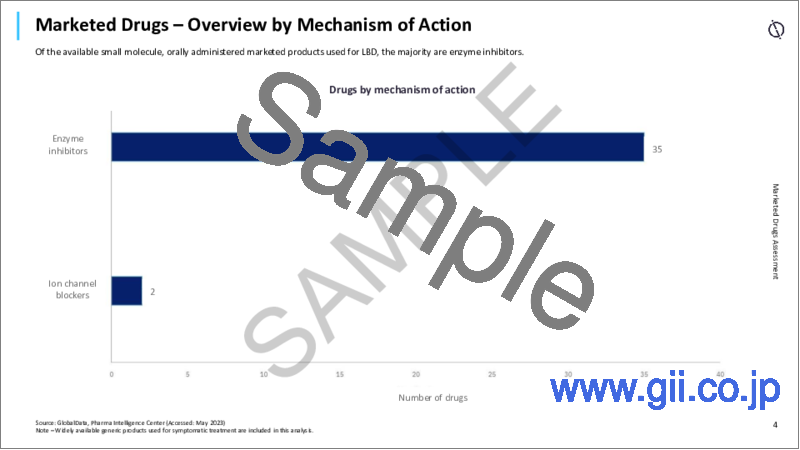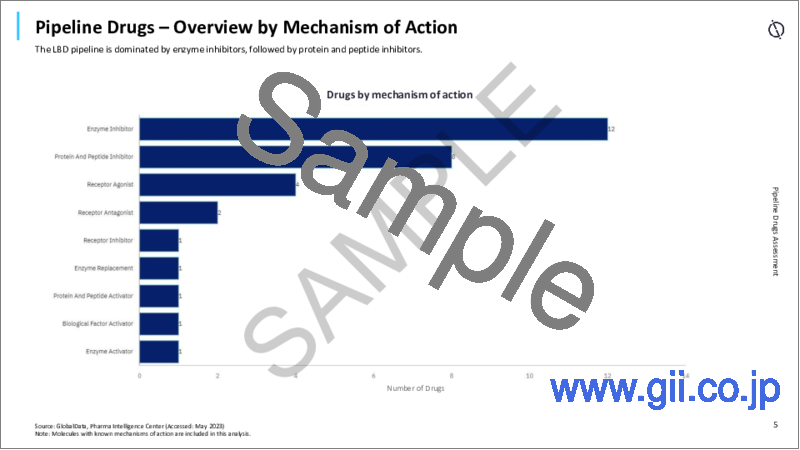|
|
市場調査レポート
商品コード
1284036
レビー小体型認知症(LBD)の上市済みおよびパイプライン薬剤評価、臨床試験、競合情勢Lewy Body Dementia (LBD) Marketed and Pipeline Drugs Assessment, Clinical Trials and Competitive Landscape |
||||||
カスタマイズ可能
適宜更新あり
|
|||||||
価格
| レビー小体型認知症(LBD)の上市済みおよびパイプライン薬剤評価、臨床試験、競合情勢 |
|
出版日: 2023年05月15日
発行: GlobalData
ページ情報: 英文 67 Pages
納期: 即納可能
|
- 全表示
- 概要
- 目次
概要
当レポートでは、レビー小体型認知症(LBD)の臨床試験市場について調査し、市場の概要とともに、上市済みおよびパイプライン薬剤、臨床試験動向、主要企業、将来の市場促進要因などを提供しています。
目次
第1章 序文
第2章 主な調査結果
第3章 疾患情勢
- 疾患の概要
- 疫学の概要
- 治療の概要
第4章 上市済み薬剤評価
- 主要な上市済み薬剤
- 作用機序別の概要
- 投与経路別の概要
- 市販薬のプロファイルと売上予測
第5章 価格設定と償還評価
- 年間治療費
- 価格設定と償還までの時間
第6章 パイプライン薬剤評価
- 第Ⅲ相パイプライン薬剤
- 開発段階別の概要
- 分子タイプ別の概要
- 作用機序別の概要
- 投与経路別の概要
- 医薬品特異的相転移成功率(PTSR)と承認の可能性(LoA)
- 治療領域および適応症固有のPTSRおよびLoA
第7章 臨床試験の評価
- 歴史的概要
- 相別の概要
- 試験状況別の概要
- 進行中および計画中の試験の相別の概要
- 仮想コンポーネントを使用した臨床試験
- 地理的概要
- 地域別の単一国および多国籍試験
- 上位20のスポンサーと相別の内訳
- 上位20スポンサーの試験状況別内訳
- エンドポイント試験状況別の概要
- 人種および民族別の概要
- 登録データ
- 治験サイトの上位20か国
- 世界のトップ20サイト
- 実現可能性分析- 地理的概要
- 実現可能性分析- ベンチマークモデル
第8章 取引の情勢
第9章 商業的評価
- 主要な市場参入企業
第10章 将来の市場促進要因
第11章 付録
目次
Product Code: GDHC111CL
Abstract
This reports provides a data-driven overview of the current and future competitive landscape in LBD therapeutics.
- There will be more than 1.1 million diagnosed prevalent cases of LBD in 2023 in the 16 countries covered in GlobalData's epidemiology forecast.
- Currently, there are three marketed products for the treatment of LBD.
- R&D activity within the LBD space is negligible, with no pipeline products in late-stage clinical development.
- Commercial sponsors dominate clinical trial development in LBD, with the US and the UK emerging as the key countries for conducting trials in this disease space.
- Deals involving partnerships were the most common type of deals globally involving companies developing LBD assets.
Scope
GlobalData's LBD: Competitive Landscape combines data from the Pharma Intelligence Center with in-house analyst expertise to provide a competitive assessment of the disease marketplace.
Components of the report include:
- Disease Landscape
- Disease Overview
- Epidemiology Overview
- Treatment Overview
- Marketed Products Assessment
- Breakdown by Mechanism of Action, Molecule Type, Route of Administration
- Product Profiles with Sales Forecast
- Pricing and Reimbursement Assessment
- Annual Therapy Cost
- Time to Pricing and Time to Reimbursement
- Pipeline Assessment
- Breakdown by Development Stage, Mechanism of Action, Molecule Type, Route of Administration
- Product Profiles with Sales Forecast
- Late-to-mid-stage Pipeline Drugs
- Phase Transition Success Rate and Likelihood of Approval
- Clinical Trials Assessment
- Breakdown of Trials by Phase, Status, Virtual Components, Sponsors, Geography, and Endpoint Status
- Enrolment Analytics, Site Analytics, Feasibility Analysis
- Deals Landscape
- Mergers, Acquisitions, and Strategic Alliances by Region
- Overview of Recent Deals
- Commercial Assessment
- Key Market Players
- Future Market Catalysts
Reasons to Buy
- Develop and design your in-licensing and out-licensing strategies through a review of pipeline products and technologies, and by identifying the companies with the most robust pipeline.
- Develop business strategies by understanding the trends shaping and driving the LBD market.
- Drive revenues by understanding the key trends, innovative products and technologies, market segments, and companies likely to impact the global LBD market in the future.
- Formulate effective sales and marketing strategies by understanding the competitive landscape and by analyzing the performance of various competitors.
- Identify emerging players with potentially strong product portfolios and create effective counter-strategies to gain a competitive advantage.
- Organize your sales and marketing efforts by identifying the market categories and segments that present maximum opportunities for consolidations, investments, and strategic partnerships.
Table of Contents
Table of Contents
1 Preface
- 1.1 Contents
- 1.2 Report Scope
- 1.3 List of Tables and Figures
- 1.4 Abbreviations
2 Key Findings
3 Disease Landscape
- 3.1 Disease Overview
- 3.2 Epidemiology Overview
- 3.3 Treatment Overview
4 Marketed Drugs Assessment
- 4.1 Leading Marketed Drugs
- 4.2 Overview by Mechanism of Action
- 4.3 Overview by Route of Administration
- 4.4 Marketed Drugs Profiles and Sales Forecasts
5 Pricing and Reimbursement Assessment
- 5.1 Annual Therapy Cost
- 5.2 Time to Pricing and Reimbursement
6 Pipeline Drugs Assessment
- 6.1 Phase III Pipeline Drugs
- 6.2 Overview by Development Stage
- 6.3 Overview by Molecule Type
- 6.4 Overview by Mechanism of Action
- 6.5 Overview by Route of Administration
- 6.6 Drug Specific Phase Transition Success Rate (PTSR) and Likelihood of Approval (LoA)
- 6.7 Therapy Area and Indication-specific PTSR and LoA
7 Clinical Trials Assessment
- 7.1 Historical Overview
- 7.2 Overview by Phase
- 7.3 Overview by Status
- 7.4 Overview by Phase for Ongoing and Planned Trials
- 7.5 Trials with Virtual Components
- 7.6 Geographic Overview
- 7.7 Single-Country and Multinational Trials by Region
- 7.8 Top 20 Sponsors with Breakdown by Phase
- 7.9 Top 20 Sponsors with Breakdown by Status
- 7.10 Overview by Endpoint Status
- 7.11 Overview by Race and Ethnicity
- 7.12 Enrollment Data
- 7.13 Top 20 countries for Trial Sites
- 7.14 Top 20 Sites Globally
- 7.15 Feasibility Analysis - Geographic Overview
- 7.16 Feasibility Analysis - Benchmark Models
8 Deals Landscape
- 8.1 Mergers, Acquisitions, and Strategic Alliances by Region
- 8.2 Recent Mergers, Acquisitions, and Strategic Alliances
9 Commercial Assessment
- 9.1 Key Market Players
10 Future Market Catalysts
11 Appendix
- 11.1 Methodology
- 11.2 Methodology - Sales Forecast
- 11.3 Methodology - Pricing and Reimbursement
- 11.4 Methodology - PTSR and LoA Analysis
- 11.5 About the Authors
- 11.6 Contact Us
- 11.7 Disclaimer
お電話でのお問い合わせ
044-952-0102
( 土日・祝日を除く )





